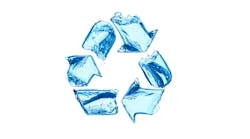During testimony on February 26, 2009, before the Subcommittee on Commerce, Trade and Consumer Protection and the Committee on Energy and Commerce, John Stephenson, director of Natural Resources and the Environment said, “Of the over 83,000 chemicals currently in the Toxic Substance Control Act (TSCA) inventory, about 62,000 were already in commerce when EPA (Environmental Protection Agency) began reviewing chemicals in 1979. Since then, over 21,000 new chemicals were added to the inventory and are now in use as existing chemicals.”
Until relatively recently, the residuals of many of these chemicals could not be detected at the levels at which they are present in our air, soil and/or water. However, due to our relatively recently developed ability to detect these contaminants of emerging concern at the parts per billion (ppb) and, in some cases, parts per trillion (ppt) level, municipal water suppliers will soon be mandated by the public and regulatory community to remove the “cocktail” of these contaminants, which are now detectable in our water supplies. As such, modern societies are truly at a crossroads and have three very distinct pathways to choose from.
Three paths to take
First, we can invest/spend billions nationwide in engineering, infrastructure, energy and chemical costs and process residuals disposal to remove chronic health risks from contaminants of emerging concern using centralized treatment, but does it make sense to do so when we ingest less than one percent of the water produced by a municipal water treatment plant?
Municipal water treatment plants do an excellent and efficient job in their vital role of eliminating acute health risks from pathogenic bacteria and viruses as well as protozoa, such as giardia lamblia, and Cryptosporidium parvum. However, even if we eliminate microbial threats using centralized treatment, the potential for contamination in the water distribution system cannot be eliminated.
Indeed, Craun and Calderon (AWWA Journal, Vol. 93, 2001) found that 30.3 percent of all waterborne disease outbreaks were attributable to contamination of the water distribution system subsequent to centralized treatment.
Second, the huge growth in bottled water sales is indicative of widespread concern about our municipal drinking water supply. Although high purity can be attained with bottled water, it has significant drawbacks, such as:
- In disaster situations it may be unavailable and/or undeliverable when it is most needed.
- Transportation efficiency pales in comparison to coupling point-of-use treatment with existing municipal water distribution systems.
- Bottle production is resource intensive.
- It frequently costs $1.00/liter compared to about $0.06/liter for a sophisticated POU system.
And, lastly, point-of-use systems can be engineered to efficiently and economically remove contaminants of emerging concern, such as residual pharmaceuticals and endocrine disrupting compounds, while serving as the “final barrier” in the municipal water industry’s longstanding multiple barrier approach to the protection of the public health. Even with “state-of the-art” centralized treatment, the potential for contamination of our distribution systems will never be completely eliminated.
On May 1, 2010, the Wall Street Journal reported, “A major water-pipe break outside Boston Saturday caused state officials to order residents in the city and dozens of surrounding towns to boil their drinking water, affecting about two million residents.”
Rather than investing billions nationwide to treat our drinking water using centralized treatment beyond treatment levels generally employed now and knowing that we will not be able to eliminate distribution system risks, the regulatory community and municipal treatment industry should embrace POU as the path that will:
- Efficiently address chronic health risks from contaminants of emerging concern in the less than one percent of municipal water that is ingested.
- Address contamination of the distribution system subsequent to centralized treatment. Although major main breaks make the news, during power interruptions, negative pressure events can occur, which may go undetected. During these events, distribution systems, which are not leak tight, can become contaminated. According to research, it is not uncommon for water systems to lose more than 10 percent of the total water production through leaks in pipelines.
- Reliably provide potable water during civil emergencies.
- Produce the smallest carbon footprint.
- Will allow modern societies to more effectively allocate our precious financial resources to other societal health needs.
- Be relatively easily modified to remove yet to be developed compounds for a fraction of the cost, which modifications to centralized treatment would require.
The final barrier
The time is ripe for the POU research and manufacturing community, with the support of the Water Quality Association, to develop POU systems that will induce the regulatory community and municipal water supply industry to embrace POU as the “final barrier.” To help that happen, I submit that POU systems need to include the following elements/processes:
- A countertop unit, which can easily be “swapped out” by the municipal supplier on a routine basis, most likely every six to 12 months. The unit needs to be less than 18 inches high so that it will fit in the space typically found between base cabinets and wall cabinets in kitchens. It needs to be a “stand alone/portable” system to avoid installation costs as well as associated complications, such as building access.
- The unit needs approximately one liter influent tank and approximately one liter removable treated water effluent tank. Water from the influent tank would be pumped by a small universal voltage 12V DC pump, which would include an adapter to allow powering the unit from a vehicle’s 12V cigarette/power outlet during power outages/civil emergencies (or when away from home), through the UV and filtration/adsorption components. It needs to include a syringe that will allow manually forcing water through the filtration/adsorption components in the event of pump failure. The system needs to be engineered to ensure adequate contact time with UV whether in pressure mode or when using the syringe. Some homeowners will undoubtedly insist on placing the unit under the counter so the influent connection, which would be used for the syringe during pump failure needs to be designed to accept a typical quick disconnect fitting, as does the entry to the effluent tank (to allow connection to a dedicated faucet).
- A 10 micron sediment filter to trap suspended particles from the distribution system or for use as a pre-filter for untreated water during civil emergencies.
- 12V Class “A” UV disinfection as defined by NSF 55 between the 10 micron sediment filter and less than 1.0 micron/activated carbon filter(s) to minimize the potential for inoculation of the carbon adsorption stage.
- Absolute less than 1.0 micron filtration and activated carbon adsorption complying with NSF 53 for health effects (the system could include several carbon adsorption cartridges to lengthen the service interval and/or to employ removal of polar compounds). Although reverse osmosis (RO) needs to be employed in some situations, the vast majority of applications are better supplied with less than 1.0 micron filtration and adsorption as healthful trace minerals are not removed and the waste stream generated by RO is avoided.
- 12V Class “A” UV disinfection downstream of less than 1.0 micron filtration and activated carbon adsorption to inactivate any opportunistic or frank pathogens that may multiply in the activated carbon. Note: Filtration systems, which can exclude viruses without the need for a backflush step (and associated maintenance and waste generation), could be employed instead of UV.
- The system needs to include a chlorine test kit; absence of a chlorine residual in the effluent tank water will serve as a surrogate for the efficacy of the carbon adsorption process. In instances in which there has been contamination of the municipal supplier’s distribution system and in which no chlorine residual is detectable in the tank influent supply, the Class “A” UV disinfection process (or filtration noted in “e”) will ensure the safety of the water from acute exposures related to microbiological contamination. Note: In the rare instance that there is no detectable chlorine residual in the influent, the certainty of adequate adsorption of contaminants generally associated with chronic exposures will not be readily verifiable until chlorine residual is re-established; if the chlorine residual is not restored in a timely manner, it may be advisable to prematurely service the unit.
Paradigm shift
It is likely that even though systems with the above detailed attributes are developed, the regulatory community and municipal water supply industry will be slow to embrace a paradigm shift to POU. That said, in the interim, there remains a huge unaddressed POU market segment that is eagerly awaiting systems employing these elements/processes.
It is also likely there are numerous small utilities that would serve as beta sites for systems that the POU manufacturing community develops. I considered developing the system described above on my own as a “start-up” enterprise and then realized that it made far more sense to develop partnerships with the POU research and manufacturing community to ensure that whatever systems are considered for production are fully scrutinized prior to production by those who already have successful track records in the POU marketplace.


